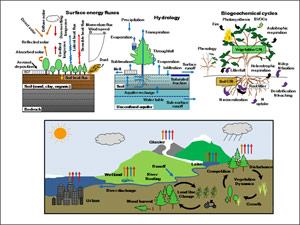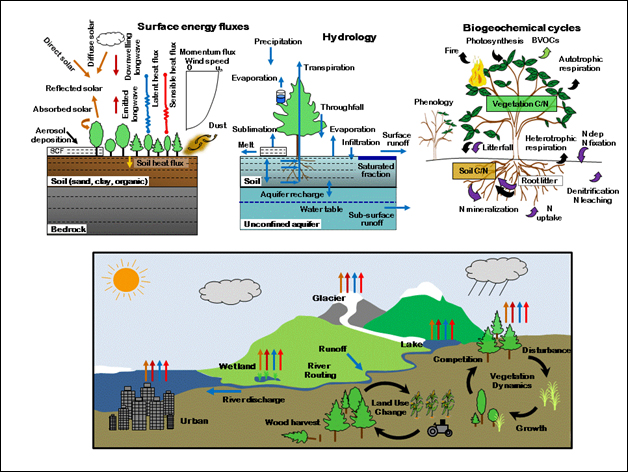Community Land Model
 Welcome to the Community Land Model.
Welcome to the Community Land Model.
The Community Land Model is the land model for the Community Earth System Model (CESM).
It is a collaborative project between scientists in the Terrestrial Sciences Section (TSS) and the Climate and Global Dynamics Division (CGD) at the National Center for Atmospheric Research (NCAR) and the CESM Land Model and Biogeochemistry Working Groups. Other principal working groups that contribute to the CLM are the Chemistry-Climate, Paleoclimate, Climate Change, and Land Ice Working Groups.
The model formalizes and quantifies concepts of ecological climatology. Ecological climatology is an interdisciplinary framework to understand how natural and human changes in vegetation affect climate. It examines the physical, chemical, and biological processes by which terrestrial ecosystems affect and are affected by climate across a variety of spatial and temporal scales. The central theme is that terrestrial ecosystems, through their cycling of energy, water, chemical elements, and trace gases, are important determinants of climate. The land surface is a critical interface through which climate change impacts humans and ecosystems and through which humans and ecosystems can effect global environmental change (iLEAPS Newsletter article on CLM).
The model represents several aspects of the land surface including surface heterogeneity and consists of components or submodels related to land biogeophysics, the hydrologic cycle, biogeochemistry, human dimensions, and ecosystem dynamics. Specific processes that are represented include:
- Vegetation composition, structure, and phenology
- Absorption, reflection, and transmittance of solar radiation
- Absorption and emission of longwave radiation
- Momentum, sensible heat (ground and canopy), and latent heat (ground evaporation, canopy evaporation, transpiration) fluxes
- Heat transfer in soil and snow including phase change
- Canopy hydrology (interception, throughfall, and drip)
- Snow hydrology (snow accumulation and melt, compaction, water transfer between snow layers)
- Soil hydrology (surface runoff, infiltration, redistribution of water within the column, sub-surface drainage, groundwater)
- Plant hydrodynamics
- Stomatal physiology and photosynthesis
- Lake temperatures and fluxes
- Dust deposition and fluxes
- Routing of runoff from rivers to ocean
- Volatile organic compounds emissions
- Urban energy balance and climate
- Carbon-nitrogen cycling
- Dynamic landcover change
- Land management including crops and crop management and wood harvest
- Ecosystem Demography (FATES, optional)
The current version of the Community Land Model is CLM5.
References
- Bibliography of papers utilizing and/or developing CLM
- Lawrence, D.M., et al., 2018. The Community Land Model version 5: Description of new features, benchmarking, and impact of forcing uncertainty. in prep for J. Adv. Model. Earth Sys..

CESM Project
The Community Earth System Model (CESM) is a fully-coupled, global climate model that provides state-of-the-art computer simulations of the Earth's past, present, and future climate states.
CESM is sponsored by the National Science Foundation (NSF) and the U.S. Department of Energy (DOE). Administration of the CESM is maintained by the Climate and Global Dynamics Laboratory (CGD) at the National Center for Atmospheric Research (NCAR).
CLM Overview
CLM Model Description
- Surface Heterogeneity
- Biogeophysics
- Hydrologic Cycle
- Biogeochemistry
- Human Dimensions
- Ecosystem Dynamics

